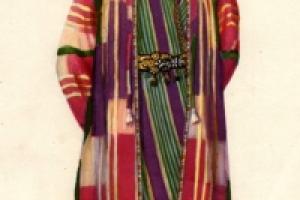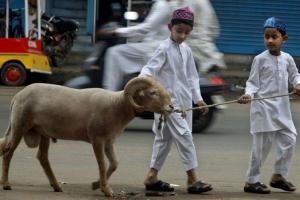Major cities of Turkmenistan. Cuisine and restaurants. State symbols of Turkmenistan: flag, coat of arms and anthem
brief information
Of all the Central Asian countries, the least known is, of course, Turkmenistan. For many years this country was closed to foreigners who only knew that it had a lot of deposits of natural gas and oil. Only in recent years, foreigners are gradually beginning to discover Turkmenistan, where, as it turns out, there are picturesque landscapes of the Karakum desert, green oases, mountain ranges, ancient cities, mausoleums, mosques, ruins of ancient fortresses, nature reserves, as well as traditional nomad villages.
The most important industry is the production of natural gas and oil. Large gas fields are not in the Caspian Sea, but on the mainland. Two thirds of natural gas production is exported. Oil as an export is less significant. The country's huge dependence on natural gas exports is linked to dangers such as the collapse of energy prices on the world market or the consequences of a slowing economy, such as whether future production targets will be met depends on urgently needed infrastructure investments, some of which are still from the Soviet Union. times.
Geography of Turkmenistan
Turkmenistan is located in Central Asia. In the east and northeast, Turkmenistan borders on Uzbekistan, in the south and southwest - on Iran, in the south - on Afghanistan, and in the north and northwest - on Kazakhstan. In the west, the shores of this country are washed by the waters of the Caspian Sea. The total area of Turkmenistan is 491,200 sq. km., and the total length of the state border is 3,736 km.
In addition, the constant turnover of personnel in leadership positions has a disturbing effect, a game of exchange and incarceration designed by Berdymukhammedov to maintain control over the state apparatus. Another export product is cotton, which is grown on 000 hectares of irrigated land and has a yield of more than 1 million tons. This places Turkmenistan in or among the producing countries. Agriculture gives about 30% of workers to work. The tourism sector is underdeveloped. The reasons for the decline are, in addition to bureaucratic problems, repressive conditions in the country, as well as the obligation to constantly carry out an accompanying person.
More than 80% of the territory of Turkmenistan is occupied by the Karakum desert, mainly in the center of the country. In the south is the Kopetdag mountain system. In general, about 15% of the territory of Turkmenistan is occupied by foothills and mountains. The highest peak of this country is Mount Airy-Baba, whose height reaches 3139 m.
The Amu Darya River flows in the east of Turkmenistan. This is the only big river in Turkmenistan.
In the Caspian, Turkmenistan is a traditional nomadic country with vast desert landscapes. The nomadic tradition still characterizes the country's culture, which is rich in oil and gas fields. Incidentally, Germany also receives natural gas indirectly from Russia through Russia, in which numerous German companies are involved in infrastructure expansion. Tourism in Turkmenistan, which is home to about 95 percent of sandy and scarce deserts, has yet to be declared, which is mainly due to government immigration regulations.
It has many cultural monuments that are associated with the nomadic tradition, but are less known in modern cities. The world cultural heritage of the country includes the ruins of the city of Merv in the Karakum desert and the ruins of ancient capital Gurganch in the city of Konergench, which lies on the edge of the Karakum in the west. In the first century, the city was an important trading center in the cultural region of Khorezmin. In the 16th century, Genghis Khan built a dam for the city. The coast of the Caspian Sea and the Karakum desert are among the interesting landscapes of Turkmenistan.
Capital
The capital of Turkmenistan is Ashgabat, which is now home to about 750,000 people. Archaeologists claim that a human settlement in the area of modern Ashgabat already existed around the 2nd century BC. The city of Ashgabat itself was founded in 1881.
Official language
In Turkmenistan, the official language is Turkmen, which belongs to the Turkic languages.
The bizarre desert landscape offers a lot for nature lovers and adventurers. The modern metropolis is the cultural center of the country. Along the central boulevard, you can see many magnificent buildings that also document the wealth of the country. Turkmenistan is a landlocked country in Central Asia and is located on the southeastern coast of the Caspian Sea. The country borders Kazakhstan in the north, Uzbekistan in the east, Iran in the west, and Afghanistan in the south. Almost the entire country is dominated by the Central Asian Karakum desert.
Religion
About 89% of the population of Turkmenistan is Muslim, and another 9% of the population is Orthodox Christianity.
State structure of Turkmenistan
According to the current Constitution, Turkmenistan is a parliamentary republic headed by the President. The unicameral parliament in Turkmenistan is called the Mejlis, it consists of 125 deputies.
On the northern outskirts, the desert landscape changes into Uzbekistan. The desert was dominated by the culture of nomads and oases. The Silk Road has become the main trade route through the bizarre desert. In ancient times and the Middle Ages, the city of Merv was the most important trading city in the southern provincial center. The ruins of Merv today are one of the most visited attractions in the country, which is composed mainly of Sunni Muslims. The capital Ashgabat was founded near an important western oasis. The economic metropolis of about a million people is located on the Karakum Canal, which stretches for about 500 kilometers from the east to the Caspian Sea.
There are only two political parties in Turkmenistan - the Democratic Party of Turkmenistan and the Party of Industrialists and Entrepreneurs.
Climate and weather
The climate in Turkmenistan is sharply continental, it is characterized by hot, dry summers and mild, short winters. In summer, the air temperature in Turkmenistan can easily reach +40C. Winter begins in December, the average air temperature at this time of the year is + 10-15C. Snowfalls in Turkmenistan are rare.
The country's only international airport, Ashgabat Airport, is located not far from the capital. In addition to the capital, major cities such as Turkmenabat on the eastern border with Uzbekistan and Dashoguz in the northeast are among the largest metropolitan areas.
The capital Ashgabat is dominated by monumental buildings built under the ubiquitous President Saparmurat Niyazov. Impressive buildings include, among others, the Independence Monument, the Historical Museum or the Turkmenbashi Mausoleum. Outside the city center in the mountains of Kopet-Dag rises the tower of Turkmenistan on the metropolis. The magnificent buildings of the capital also include the presidential palace as a domed building or the parliament building. The most visited museum is the National Museum of Ashgabat. Impressive structures such as the Mausoleum of Sayyid Ahmad or the Mausoleum of Sultan Tekish are featured here.
The best time to visit Turkmenistan is spring or autumn, when it is not quite hot (unless, of course, you like the heat).
Sea in Turkmenistan
In the west, the shores of Turkmenistan are washed by the waters of the Caspian Sea. The length of the Turkmen coast of the Caspian Sea is 1,768 kilometers. Many interesting birds live near the Caspian Sea, including even pink flamingos.
The capital of the former kingdom of Khorezm is one of the most visited Muslim pilgrimage sites in Turkmenistan. The city of Nisa is located a few kilometers from the capital and is the capital of the Parthians, an ancient Iranian people who built Central Asia from Chr.
In the Karakum desert near Derweze, the Derweze crater is an artificial spectacle of nature. When the underground drilling platform collapsed and the release of toxic gases had to be avoided, it was burned down, but the fire did not go out. Locals call the Dervze crater, which has become a tourist attraction, the gateway to hell. On the eastern shore of the Caspian Sea, in the lagoon, the Kara-Bogas-Gol reservoirs are one of the natural beauties of the country. There is one of the largest deposits in the Kara-Bogas-Gol lagoon.
Rivers and lakes
There are no large rivers in Turkmenistan, with the exception of the Amu Darya, which flows through the east of the country. Other well-known Turkmen rivers are Murgab, Tejen, Kyzyl-Arvat, Karasu. By summer, almost all Turkmen rivers become very shallow.
In the north of Turkmenistan there is Sarykamysh Lake, the largest reservoir in this country (its area is 5000 km2).
Part of traveling in Central Asia Traveling in Turkmenistan. There are only a few photos from Turkmenistan on the internet, and it's even harder to find travel reports. This is not surprising, since Turkmenistan - with less than a thousand visitors - is among the top ten, least visited countries in the world. Geographically, the Central Asian country is located between Asia and Europe. In the east it borders on Iran and in the west on the Karakum desert. In the Middle Ages, the trading oases of Merv and Konya Urgench personified business on the Silk Road.
When it comes to freedom of the press and human rights, Turkmenistan is also very far ahead - at least when you look at the list from the back. Turkmenistan is different, but anyway. Just because we have so little information about Turkmenistan, we wanted to take a closer look at the people and the cities. Since our transit visa only allowed us a four-day "transit", we entered into an extremely strict schedule. Our main destinations were the provincial capitals of Dashoguz and Turkmenabat, as well as the capital Ashgabat.
Story
In the 8th century A.D. In the steppes of Central Asia, the nomadic Oghuz tribes settled, who arrived there from Mongolia. It was the Oguzes who became the ethnic predecessors of modern Turkmens.
Before the Mongol invasion, the territory of modern Turkmenistan was under the rule of the Seljuks and the state of Khorezmshahs. After the weakening of the Mongol Empire, Turkmenistan, from the 16th century, was part of the Bukhara and Khiva Uzbek khanates.
Customs and traditions of Turkmenistan
In fact, Turkmenistan is a country of great contrasts: while people in the provinces live a simple existence, capital spares no effort and does not try to build a glittering metropolis in the middle of the desert. Formerly Chardjou, Chardzhyu and Amul. We reached the Farab border post from Uzbekistan at exactly 13:00. Completing the customs declaration in Russian prepared us for some problems, just as we did when we entered Uzbekistan. Our redundant Uzbekistan templates as well as helpful Turkmens helped us complete.
In the second half of the 19th century, Turkmenistan was annexed to the Russian Empire (this process ended by 1885). In the early 1920s, the Turkmen SSR was formed on the territory of modern Turkmenistan, which was part of the USSR.
The independence of Turkmenistan was declared in September 1991.
Culture of Turkmenistan
The roots of Turkmen culture go back to the nomadic tribes of the Oghuz, who came to Central Asia from Mongolia. In the Middle Ages, Islam spread among the Turkmens, and this had a decisive influence on their culture.
We then handed in our passports at the counter and paid at the next counter the mandatory admission fee of twelve dollars per person. After we had the stamp in our passport, we still had to provide a customs declaration. Outside the air-conditioned building, we showed our stamped passport at the exit of the fence and were faster in Turkmenistan than thought!
In conclusion, it can be said that since the European traveler is on foot at land borders, it is predominantly processed and partially processed within a few minutes. The time-saving strategy of going to the border with a domestic driver and finding a taxi again after crossing the border is a great way to get started. On the fence, several taxi drivers were already waiting for border workers. After some unsuccessful and extremely difficult negotiations, we treated ourselves to a little refreshment at a tea house 200 meters from the hotel.
Turkmen celebrate traditional folk holidays(“Snowdrop Festival”, “Tulip Festival”, “Horse Festival”, “Bakhshi Day”), as well as all Muslim holidays (Ramadan-Bayram, Kurban-Bayram, Navruz).
In addition, every Turkmen family celebrates “Sach-Alysh” (Day of cutting the first hair), “Akgoyun” (63rd birthday of a man), “Sowing Festival” and “Grape Festival”.
The tea house, as well as the border station, are located on the mighty branch of the Amudarya River. We have already exchanged money with the old grandmother from the car with a fee of 1 manat for 50 changed manats. After further negotiations at the tea house, we were able to secure our target price of 15 manats for a trip to Turkmenabat with a taxi driver following us in a car.
We have a private air-conditioned taxi for the next 20 kilometers. After ten kilometers, right in front of the village of Farab, our passports were checked by the police. A few minutes later we reached Turkmenabat, the capital of the Lebap province, and about a thousand inhabitants - the second largest city in Turkmenistan. We sent the driver to our hotel, the only hotel with permission to accommodate foreigners in Turkmenabat. From there it is two kilometers from the city center. Upon arriving at the hotel, the concierge immediately jumped out of their seats in the lobby to greet us.
Kitchen
The cuisine of Turkmenistan is very similar to the cuisine of other Central Asian countries (especially Iranian), and mainly consists of rice, vegetables, and, of course, meat (lamb, beef, poultry).
Lunch usually starts with soup. Then the main dishes are served, among which pilaf occupies a special place. Tourists in Turkmenistan are recommended to try "chorba" (soup with meat broth), "manty" (steamed dumplings), "kebal" (barbecue), fried lamb. Turkmens make pilaf from lamb (sometimes they replace it with poultry meat), adding spices, onions, carrots, raisins, peas and quince to it.
State symbols of Turkmenistan: flag, coat of arms and anthem
The letter contained our plane tickets for the next day. The toilets are not in perfect condition, we had to change the room because the shower didn't work. But since there are no other guests, you have enough space to try. Mini bar and air conditioning worked well. The outdoor pool behind the hotel seems to be unused and empty.
State structure of Turkmenistan
After checking out, we wanted to explore the city. Directly on the neighboring property stood an undeniable palace with a huge portrait of President Berdymukhammedov. Here one could convince oneself day and night of the short clips of the progressiveness of Turkmenistan. Surprisingly impressive - especially compared to Uzbekistan, which was only a few minutes away by car - we stopped the car for three manats in the city center. It should be noted that the prices for attractions in Turkmenistan are relatively low, and drivers are often not interested in bargaining.
Turkmens like to drink "gok chai" - green tea with dried fruits. Sometimes herbs, such as mint, are added to tea. In addition, fermented milk drinks made from camel and sheep milk (“agaran”, “suzme”, “teleme”, “gatyk”, etc.) are popular in Turkmenistan.
Good things are made in Turkmenistan alcoholic drinks- wine and cognac. Many tourists buy Turkmen wine and Turkmen cognac as souvenirs.
Basically, they like to communicate with foreigners and proudly praise the progress and development of sovereign Turkmenistan. Not really sure what we could head to first was our main destination Turkmenabat. On the trip, we marveled at the spaciousness, cleanliness, and architecture of the city in transition. From the railway station we headed towards the bazaar, hoping to exchange a few bucks. On the way to the bazaar, we passed the first golden statue of ex-president Niyazov. Here we had a short conversation with a Turkmen woman who had just arrived from the bazaar.
Sights of Turkmenistan
In Turkmenistan, inquisitive tourists will see ancient mausoleums, minarets, mosques, palaces, fortresses, ruins of ancient cities, settlements, caravanserais, as well as other historical and cultural monuments. The top 10 best sights of Turkmenistan, in our opinion, may include the following:
- Anau Fortress
- Ruins of the Parthian city of Nisa
- Cave city Ekedeshik
- Ancient caravanserai Tasharvat
- Altyn-Depe fortress near Kushka
- Mausoleum of Sultan Sanjar
- Mausoleum of Princess Torebeg Khanym
- Settlement of Gara-Depe near Kushka
- Great fortress in Merv
- Mausoleum of Il-Arslan
Cities and resorts
The largest cities in Turkmenistan are Turkmenabad, Turkmenbashi, Mary, Dashoguz, and, of course, the capital, Ashgabat.
Turkmenistan has not only unique sights, but also beaches, mineral springs, as well as sources of therapeutic mud.
In summer, Turkmens rest on the coast of the Caspian Sea. The most popular cities for recreation on the Caspian Sea among Turkmens are Turkmenbashi, Avaz and Khazar. Dozens of hotels, sanatoriums, recreation centers, children's holiday camps have been built on the coast.
Tourists in Turkmenistan are offered very interesting excursion routes, which pass through the foothills and mountains. Travelers during sightseeing tours can see the Karlyuk caves, the Kopetdag reserve, the Boyadag mud volcano, the Um-Bar-Depe canyon with waterfalls, the Kugitang reserve, the Bakharden cave and the Badkhyz reserve.
Souvenirs/Shopping
Tourists from Turkmenistan usually bring products folk art, Jewelry from carnelian, Turkmen silk, Turkmen headdresses (skullcap, fur hat"telpek"), towels, bathrobes, Turkmen melons, cognac, wine, and, of course, Turkmen carpets.
Office Hours
Banks:
Mon-Fri: 09:30-17:30
Turkmen carpets and Akhal-Teke horses, Sunday markets and countless monuments of antiquity: the ruins of ancient fortresses of the Achaemenid dynasty and the settlements of the Parthian kingdom, ancient cities Merv, Kunya-Urgench, Nisa, medieval castles, forts, kavaran-sheds, mosques, mausoleums and tombs - that's what attracts tourists to hot Turkmenistan. Numerous studies and excavations have proved that people lived on the territory of Turkmenistan 3 million years ago!
 Of the modern sights that are definitely worth a visit in Turkmenistan, the main ones can be distinguished: cyclopean mosque « Turkmenbashi Rukhy”, the palaces of Turkmenbashi and Rukhyet, the Monument of Independence and the Arch of Neutrality, and, of course, Carpet Museum, where, among the many ancient artifacts, a modern a giant carpet of 301 sq. m- "Golden Age of the Great Saparmurat Turkmenbashi".
Of the modern sights that are definitely worth a visit in Turkmenistan, the main ones can be distinguished: cyclopean mosque « Turkmenbashi Rukhy”, the palaces of Turkmenbashi and Rukhyet, the Monument of Independence and the Arch of Neutrality, and, of course, Carpet Museum, where, among the many ancient artifacts, a modern a giant carpet of 301 sq. m- "Golden Age of the Great Saparmurat Turkmenbashi".
In addition to the most interesting historical and modern monuments, Turkmenistan has many natural attractions: huge Karakum Desert with its classic dunes, the Bakharden cave and the underground sulfur lake Kou-Ata, burning Darvaza gas crater, dinosaur plateau - Khodzhapil, Yangikala canyons, Repetek, Kugitang and Kopetdag national parks and other interesting natural objects.
Turkmenistan can actually be compared with the traditional oriental beauty, which, due to established habits and religious national principles, does not have the right to keep its face open to everyone it sees in front of it, or those who themselves have an irresistible desire to admire its extraordinary beauty. Her appearance is the silhouette that appears before our eyes when a woman in a hijab appears, and her inner world is not known to almost anyone. However, in the event that a person has exceptionally noble and serious intentions in relation to her, she can open up to him and show all the beauty that has been heard so much about, but until a certain moment remained hidden from the eyes.
Turkmenistan today, despite the strict visa regime, it is one of the popular tourist destinations Central Asia. And although the government of Turkmenistan does not strive to make life inside the country public and, in fact, is rather stingy in the development of foreign policy relations, however, the state hosts tourists, there are a number of modern hotels of the world's leading hotel chains, many private mini-hotels, etc. .
Turkmenistan surprises and delights, feeds delicious food and colorfully celebrates holidays - this country has been making connoisseurs of Asian culture fall in love with it for many years. The Turkmens themselves say that their land is sacred as the hearth of the Turkmen, pure as the conscience of the Turkmen, great as his pride and strong as his faith!
Useful information for traveling in Turkmenistan:
General information about Turkmenistan.
 Location. Turkmenistan, which during its long history has been under the rule of almost all the major rulers of the East, is now a sovereign state. Located in Central Asia, it has borders with Uzbekistan, Kazakhstan, Afghanistan and Iran. The country does not have access to the World Ocean, but the Caspian Sea provides local residents with the opportunity to listen to the sound of the surf without leaving their homeland.
Location. Turkmenistan, which during its long history has been under the rule of almost all the major rulers of the East, is now a sovereign state. Located in Central Asia, it has borders with Uzbekistan, Kazakhstan, Afghanistan and Iran. The country does not have access to the World Ocean, but the Caspian Sea provides local residents with the opportunity to listen to the sound of the surf without leaving their homeland.
Square. The territory of the country is spread over 491,200 sq. km. The lands of Turkmenistan are 80% represented by deserts. Much less fertile than their neighbors, they nevertheless make the state one of the world leaders in natural gas production.
Population Turkmenistan - 5,169,660 people.
National composition. The indigenous nation of Turkmenistan is the Turkmen, they make up 91% of the country's population, 3% are Uzbeks and 2% are Russians. Teaching in general education schools is conducted in the Turkmen language. A significant number of Uzbeks live in the valley of the Amu Darya near the Turkmen-Uzbek border. Kazakhs are concentrated mainly in the north of Turkmenistan and along the coast of the Caspian Sea.
Political structure. The country is ruled by a president. The past decade has changed the political system of the state quite a lot. If until 2006 S. Niyazov was the permanent president, then the current head should be elected for a term of up to five years. Legislation in the country is handled by the Parliament, Majlis. Before the death of S. Niyazov, the People's Council, the Halk maslahaty, also functioned in the country, and was also involved in the preparation of bills. Relatively recently, parties began to appear.
Administrative-territorial division. Turkmenistan is divided into 5 regions / velayats and one city with the rights of the region - the capital.
Capital- the city of Ashgabat with a population of approx. 900,000 people, which became the Guinness book record holder for the number of buildings made of white marble. This material, as well as a mixture of elements of Eastern and European architecture, make the capital one of the most magnificent cities in Central Asia.
Official language. The only state language is Turkmen, which is natural, because the population consists of more than 77 percent Turkmen. However, many locals are fluent in both Russian and Uzbek.
Currency unit- manat. It is possible to make payments in the country only in manats, consisting of 100 tenge. The use of other currencies is officially prohibited.
Religions. The vast majority of the population - 89% profess Sunni Islam, 9% - Christianity. Only 2 percent are representatives of other religions.
The residence of the head of the Muslims of Turkmenistan - Kazi - is located in the city of Chardzhev. There are several Muslim shrines in Turkmenistan, where pilgrimages are quite often made. These are mainly Muslim cemeteries and tombs of the Middle Ages. Among them, the most revered are Ag-Ishan near Bakharden to the north-west of Ashgabat, two religious buildings Babaghammar (Gammarbaba) near Iolotan and Kushka, the mausoleum of Serakhsbab, built on the site of the tomb of Sheikh Abul-Fazl near Serakhs.
Standard Time Zone. Clocks in Turkmenistan do not translate. It constantly differs upwards from Greenwich Mean Time by five hours.
Electricity. Sockets are used standards B and F. The voltage in them is 220 volts with a current frequency of 50 hertz.
Climate of Turkmenistan.
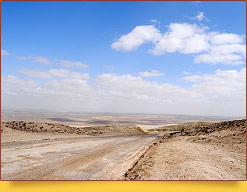 The climate of Turkmenistan is continental, arid with large temperature fluctuations, low rainfall and high evaporation. Summers are usually hot and dry, with average July temperatures of 28-32°C. Winters are mild, with little snow, but in some years there are heavy but short-term snowfalls and temperatures can drop to -20°C. Average January temperatures range from -5°C in the northeast of the country to +4°C in the south. Of course, the maximum performance can scare anyone, but they are recorded extremely rarely. The presence of the sea has a positive mitigating effect on coastal regions, making recreation in them very comfortable.
The climate of Turkmenistan is continental, arid with large temperature fluctuations, low rainfall and high evaporation. Summers are usually hot and dry, with average July temperatures of 28-32°C. Winters are mild, with little snow, but in some years there are heavy but short-term snowfalls and temperatures can drop to -20°C. Average January temperatures range from -5°C in the northeast of the country to +4°C in the south. Of course, the maximum performance can scare anyone, but they are recorded extremely rarely. The presence of the sea has a positive mitigating effect on coastal regions, making recreation in them very comfortable.
A characteristic feature of the local climate is the almost constantly blowing winds of the northern component, which bring cold air masses from the steppe regions of Kazakhstan in winter, and hot winds and stock air masses from the mountain slopes in summer, causing sandstorms and dry winds.
The best time to visit Turkmenistan- Spring ( March to May) and autumn ( September to November). From March to May, Turkmenistan is colored with fresh greenery, and the sweet aroma of flowering trees is in the air. September and October can also give a lot of pleasant sensations, when the summer heat has subsided, but nature still does not think to fall asleep. The capital of Turkmenistan has especially comfortable climatic conditions for recreation.
How to dress in Turkmenistan.
As in most secular states of Central Asia, in Turkmenistan there are no official prohibitions regarding the styles and colors of clothing. On the streets you can often meet people in national attire, but the locals do not condemn the wearing of European trousers, dresses and other outfits.
The only thing to avoid is visiting shrines in inappropriate and overly revealing clothes. The hot climate of the country suggests wearing the lightest possible clothes, mainly from cotton and other natural fabrics.
In nature, you should not use T-shirt styles where the shoulders and part of the back are open, as there is a risk of getting sunburn. It is also better not to neglect hats.
Urban shoes may well be limited to light sandals or slippers, but outside of settlements, especially in desert areas, you should put your feet in sneakers, as the region is replete with poisonous insects.
Cuisine of Turkmenistan.
 Despite their nomadic roots, which are present to some extent in most of the Central Asian republics, the people of Turkmenistan did not reduce their culinary traditions to only types of fried meat. Undoubtedly, meat has played and is playing an important role in the preparation of national dishes, but in this country, not so much second courses are common as first ones.
Despite their nomadic roots, which are present to some extent in most of the Central Asian republics, the people of Turkmenistan did not reduce their culinary traditions to only types of fried meat. Undoubtedly, meat has played and is playing an important role in the preparation of national dishes, but in this country, not so much second courses are common as first ones.
Nowhere in Central Asia can you find so many species soups like in Turkmenistan. This is flour porridge umpach-zashi and pea soup gaynatma, and tomato gara-chorba, and many other options. What unites all this diversity is that the basis for each type of soup is chorba - lamb broth. This is the same broth that is customary to drink among Kazakhs and which, seasoned with vegetables, is served to the table by Uzbeks (shurpa).
Fragrant kosushki of the Turkmen soup often surpass similar stews of their neighbors in nutritional value, and a limited amount of spices allows the taste qualities of meat and other ingredients to be fully revealed. After such first courses, the European is sometimes no longer up to the second.
Although, you should not rush to refuse, because the splendor of second courses in Turkmenistan will also impress a true gourmet. What is worth just one govurlan-et- fried lamb with tomatoes, where the balance of vegetables and meat is so well chosen that the former saturate the latter with delicate sourness, and the latter with fragrant spicy aroma and fat.
Do not ignore and Turkmen types of pilaf, even if he has already become quite boring during his trips to other countries of Central Asia. This dish is prepared in a completely different way. Very often, in addition to rice, meat, onions and carrots, various dried and fresh fruits are added, ennobling the rest of the components and bringing a touch of freshness and unusual piquancy. Only here you can taste the most unusual swim where instead of meat is used fish. It is impossible not to distinguish such pilaf from the number of similar dishes of the East.
It is worth noting that in Turkmenistan, the use in cooking seafood much more developed than in other countries of the region. This is explained by the presence Caspian Sea- a reliable supplier of this kind of goods to local markets. Therefore, dishes such as balyk-gavurdak- fish baked in pots are an integral part of the feast of local residents.
You can also enjoy the unusual taste of a number of dairy products in Turkmenistan. And many of them - chala, teleme, agarana and others are made from camel milk. Another culinary distinction of the country has become a favorite throughout the region Turkmen pastries. Biscuit write me or pies Shilekli- all of them will appeal to both adherents of oriental cuisine and lovers of European cuisine.
The cost of food in Turkmenistan.
Guests will also be pleased with the prices for local dishes in restaurants and cafes. Food products in the country are relatively cheap, which ensures the formation of fairly democratic prices. In order to eat to satiety in a metropolitan cafe, it will be enough to have 10-15 US dollars with you, and in smaller towns you can spend 8 dollars on this.
Visa and registration.
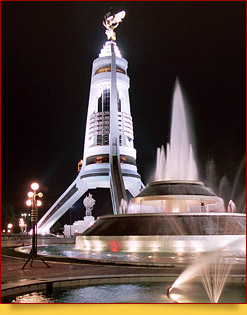 With all the richness of its tourism potential, Turkmenistan has a rather inconvenient visa policy for travelers.
With all the richness of its tourism potential, Turkmenistan has a rather inconvenient visa policy for travelers.
To visit the country, it is necessary to issue visa to Turkmenistan(more). Turkmen visas are issued on the basis of invitations issued by the State Migration Service of Turkmenistan. You can get a Turkmen visa either directly at Ashgabat International Airport (with the collection of consular fees necessary in such cases for the urgency of processing, there is also a possibility of refusal with subsequent deportation to your homeland at your own expense), and in advance at the consular department of the Embassy of Turkmenistan.
In connection with the internal policy of Turkmenistan, at present, issuing positive decisions on obtaining visas at the request of travel agencies for citizens of the CIS is extremely rare. Refusal without explanation is issued in 95 out of 100 applications.
Registration. Foreign citizens arriving in Turkmenistan for a period of more than three working days, no later than the third working day from the moment of entry into the country, must register with the State Migration Service of Turkmenistan. The hotel staff also check in arrivals and provide them with relevant documents. These certificates must be kept, otherwise problems may arise when leaving the country. Staying at visiting points (stops) without registration is allowed for a period of not more than 3 days.
Visiting border areas requires special permission.
Customs regulations of Turkmenistan.
As well as everywhere else, it is forbidden for the entrant to carry weapons, drugs, ammunition, pornographic materials and materials that pose a potential threat to the constitutional order of the state. Foreigners are also prohibited from importing and exporting local currency.
currency other states can be imported in any quantity subject to mandatory declaration, but when leaving the amount should be less. customs declaration should be filled in as detailed as possible and kept until the moment of departure from Turkmenistan. If any products were purchased on the territory of the country, then appropriate certificates should be issued for them, confirming that they do not carry historical value.
Large souvenir shops prepare the necessary export documents for the goods sold in advance, so purchases made at such outlets will save a lot of time and nerves.
It is strictly forbidden to export from the country fish and black caviar. Also prohibited for export from Turkmenistan jewelry without hallmarks, precious and semiprecious stones and their semi-finished products; bee and snake venom, mumiyo, propolis; meat of all kinds and products of its processing; plants and animals listed in the Red Book of Turkmenistan; carpets and rugs without the appropriate permission of the State Association "Turkmenhaly".
When paying for any purchases and services, it is advisable to keep receipts.
Currency of Turkmenistan.
In Turkmenistan it is forbidden to make payments in foreign currency. To exchange it, you should contact banks and  official exchange offices. Banks in the country rarely work after 17.00, but exchange offices at hotels and airports often operate around the clock.
official exchange offices. Banks in the country rarely work after 17.00, but exchange offices at hotels and airports often operate around the clock.
They accept mostly new US dollars only. Banknotes must not have defects, otherwise the employees of the point or the bank may refuse to exchange. It is categorically not recommended to get involved with bazaar money changers and illegal businessmen, tk. there is a risk of being deceived or caught by the police in conducting illegal foreign exchange transactions.
Bank cards issued outside the state, practically do not have circulation in the territory of Turkmenistan. You can use them only in large hotels and shopping malls capital Cities.
Internet in Turkmenistan.
The Internet in Turkmenistan is limited (not all sites are accessible), the connection is not very high quality, the traffic speed is low, and the prices are quite high. In recent years, the situation with the Internet in Turkmenistan has been improving, but it is still far from universal high-quality Wi-Fi.
Photographing in Turkmenistan.
In Turkmenistan, it is allowed to capture on film everything except military and some government facilities. It is also not recommended to take pictures and shoot videos at airports and border areas.
Souvenirs of Turkmenistan.
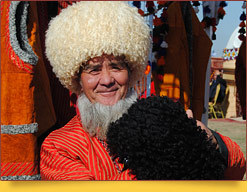 In addition to numerous photographs from Turkmenistan, it would be nice to bring some souvenirs that remind you of this wonderful country. The most popular and world-famous Turkmen products are, of course, carpets.
In addition to numerous photographs from Turkmenistan, it would be nice to bring some souvenirs that remind you of this wonderful country. The most popular and world-famous Turkmen products are, of course, carpets.
Craftswomen make them exclusively by hand, using tools and machines that have not changed in the least for hundreds of years. The subtlety of the ornament of Turkmen carpets is amazing! Looking at them, one gets the impression of a striking volume. The only drawback of such a souvenir will be its price.
Turkmens know the value not only of their carpets, but also of horses. So, for example, to take out of the country argamak(Akhal-Teke horse) will not succeed for any money. But on the shelves of shops you can find a large number of figurines of this and other breeds of horses. Ceramic or wooden, it will become a worthy decoration of your desktop.
From ceramics funny whistles are made here. The sounds extracted with their help resemble the overflowing of streams, the whistling of the desert wind and the sound of the surf. Not only a child, but also an adult will be happy with such a gift from a distant country.
If you want to protect loved one from evil eye, the artisans of Turkmenistan are ready to offer a variety of carnelian products. Jewelry made using this material drives away evil spirits and brings happiness to its owner. To the guest who does not believe in either evil or good spirits, hot Turkmenistan makes it possible to take away a piece of his warmth, placed in a telpak - a national headdress made of white sheep's fur.
National characteristics, norms of behavior and local customs.
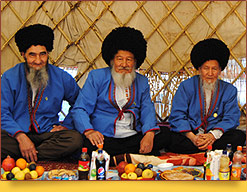 In everyday life and everyday life, Turkmens are benevolent and hospitable, calm and self-possessed people. Local customs and traditions are based on the ancient Turkic culture and Islamic religion. In the past, Iran had a strong influence on the region, then the Russian Empire.
In everyday life and everyday life, Turkmens are benevolent and hospitable, calm and self-possessed people. Local customs and traditions are based on the ancient Turkic culture and Islamic religion. In the past, Iran had a strong influence on the region, then the Russian Empire.
In addition to official laws, there are well-established traditions and unspoken principles for solving everyday issues: tribal relations are still strong here; Turkmen society of the patriarchal type, dominated by men; Elderly people enjoy special respect among Turkmens, aksakals (elders) have indisputable authority.
National holidays in Turkmenistan.
| . | January 1 - New Year. |
| . | January 12 - Memorial Day. |
| . | January 27 - Day of Defenders of the Fatherland. |
| . | February 19 - Holiday of the State Flag of Turkmenistan. |
| . | March 8 - International Women's Day. |
| . | March 21-22 - Novruz; National holiday spring. |
| . | 1st Sunday of April - Holiday "A drop of water - a grain of gold." |
| . | The last Sunday in April is the Day of the Akhal-Teke Horse. |
| . | May 9 - Victory Day. |
| . | May 18 is the Day of Revival, Unity and Poetry of Makhtumkuli in Turkmenistan. |
| . | The last Sunday of May is the Day of the Turkmen Carpet. |
| . | 2nd Sunday of August - Turkmen Melon Day. |
| . | 1 September is the day of knowledge. |
| . | October 6 - Day of Remembrance for the Victims of the 1948 Earthquake. |
| . | October 27 - Independence Day of Turkmenistan. |
| . | 1st Saturday of November - Health Day. |
| . | December 12 - Day of Neutrality of Turkmenistan. |
State symbols of Turkmenistan: flag, coat of arms and anthem.
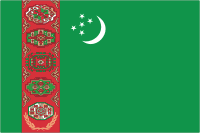 Flag.
Flag.
The flag of Turkmenistan was adopted on 02/19/1992 and is a rectangular green panel with a vertical red-burgundy stripe, which depicts five national gels, with a white crescent and five stars. Each of the gels is framed with a carpet ornament, the outer edge of which is aligned with the edges of the strip. In the lower part of the red-maroon stripe, two intersecting at the bases and directed upwards are depicted. different sides olive branches, symbolizing the status of permanent neutrality of Turkmenistan. Together with carpet gels, they form a single composition. Each olive branch consists of ten leaves decreasing towards the ends, arranged in pairs, except for the lower and upper. The larger green part in the upper left corner shows a crescent and five five pointed stars white.
Five national carpet gyols, each of which is framed by a carpet ornament, also symbolize the velayats. There is a deep philosophical meaning in the symbolism of carpet gels. The word "gel" itself has different interpretations: gul (flower) or kol (lake). All gels are built on the principle of the golden section, in proportions of 21 to 34. At the bottom of the red-burgundy stripe one-sixth of the flag wide are two intersecting olive branches, a symbol of the independence and neutrality of the nation. February 19 - Day of the State Flag of Turkmenistan.

